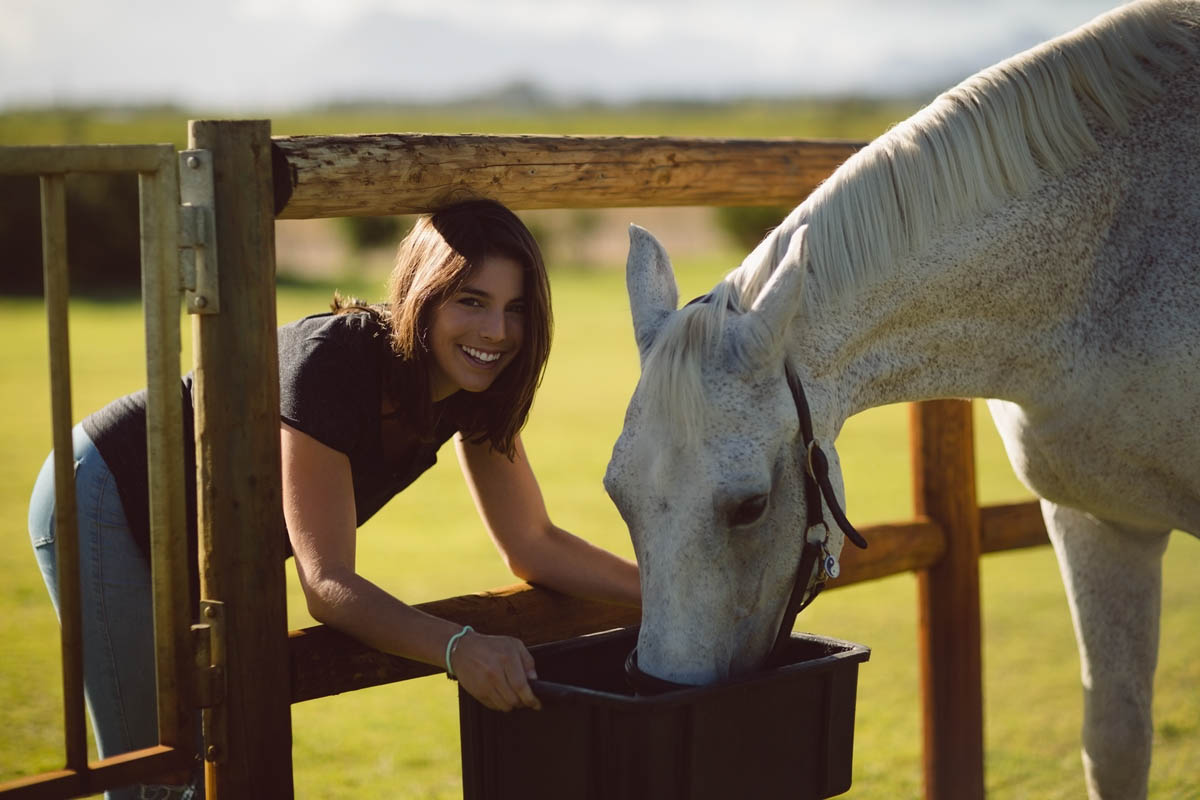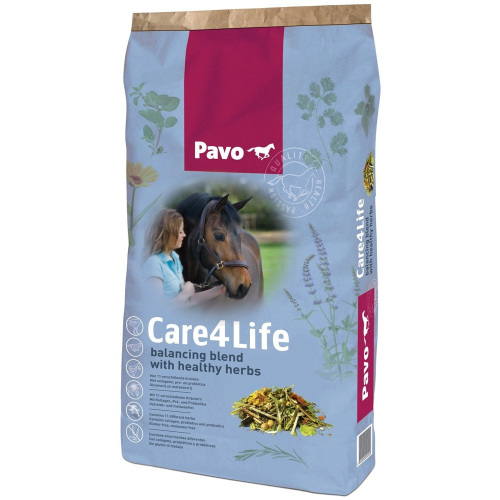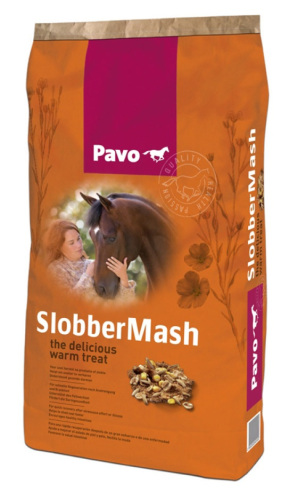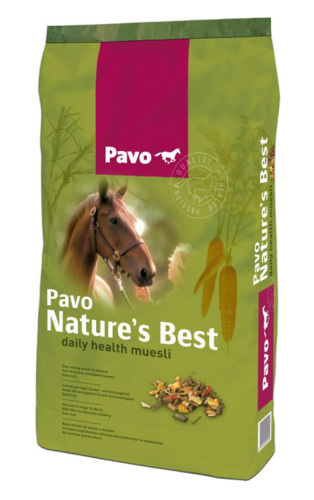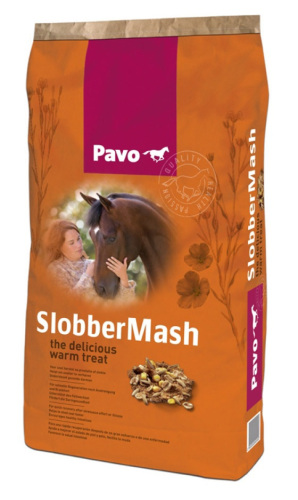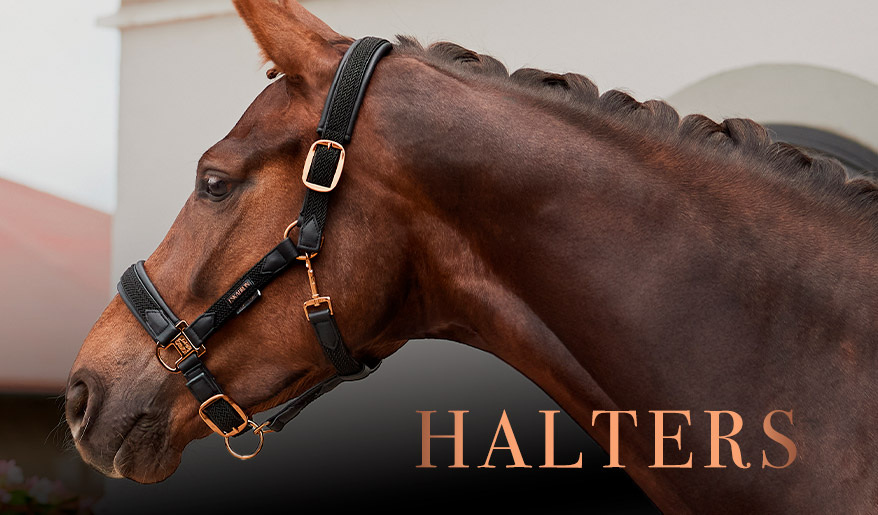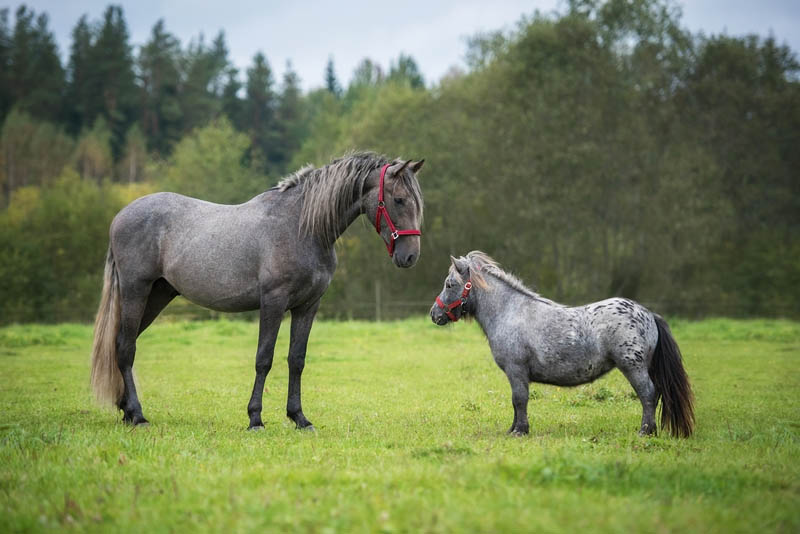

The horse’s weight depends on a few different things. Weight can tell you a lot about a horse’s health. There are some techniques and tools to help you find out the approximate weight of your horse. Read our article, to find out why weight is so important, what influences weight, and how to calculate it!
Why controlling the horse’s weight is so important?
Regular weight checkups are important to judge a horse’s health and condition. Any deviations from the normal weight can signal that a horse needs a vet visit and evaluation of its current diet as well as living conditions. It’s worth noting that a horse that is either overweight or underweight can have significant health problems. That’s why controlling the weight is so crucial for the animal’s health; it can also help you create a diet and training schedule that is perfect for your horse.

How much does a baby horse weigh?
It’s estimated that a newborn foal should weigh 10% of its mother’s weight. Foal's weight is mostly influenced by its mother, the stallion’s weight has less significance. Therefore, if a mare weighs 1102 lbs (500kg) then her newborn foal should weigh around 110 lbs (50kg). The only exception is first-time mothers, their foals are usually smaller. Twins, premature foals, and those born during a complicated birth can also have a lower weight.
How much does an adult horse weigh?
An answer to the question “How much does an average adult horse weigh?” is not easy. Weight depends on a few factors: age, breed, or health. Light horses, such as quarter horse, weigh much less than draft horses. Average horse weight for a 160-170 cm adult horse is estimated at around 1102-1323 lbs (500-600 kg). Draft horses can weigh over 1763 lbs (800 kg), while ponies usually weigh between 771 lbs to 992 lbs (350 kg to 450 kg). The weight differs between specific horses based on their living conditions and training. A horse that spends most of its time in a pasture and is only lightly ridden will weigh more than a horse of the same breed that has a strenuous training regime and well-built muscle mass.
Horse’s weight depends on the type
The horse’s weight depends on the breed’s type. In general, we can distinguish the division presenting as follows:
Miniature horses: 88 – 198 lbs (40 – 90 kg)
Ponies: 287 – 771 lbs (130 – 350 kg)
Warmbloods: 882 – 1543 lbs (400 – 700 kg)
Draft horses: 1763 –2204 lbs (800 – 1000 kg)
Horse’s weight depends on the breed
Horse’s weight can also be estimated based on its breed.
Horse breed - average weight:
| Horse Breed | Average Body Weight in Kilograms | Average Body Weight in Pounds |
|---|
| Percheron | 850.5 - 950 kg | 1876 – 2094 lbs |
| Belgian Draft Horse | 816.5 - 998 kg | 1799 – 2199 lbs |
| Suffolk Punch | 751 - 900 kg | 1653 – 1984 lbs |
| Shire | 701 - 1,200 kg | 1545 – 2645 lbs |
| Ardennais | 701 - 1,000 kg | 1545 – 2204 lbs |
| Clydesdale | 701 - 800.5 kg | 1545 – 1773 lbs |
| Irish Draught | 599 - 800.5 kg | 1318 – 1773 lbs |
| Gypsy | 590 - 726 kg | 1298 – 1600 lbs |
| Heavyweight Hunter | 590 - 698.5 kg | 1298 – 1538 lbs |
| Cleveland Bay | 549 - 701 kg | 1209 – 1545 lbs |
| Hanoverian | 549 - 651 kg | 1209 – 1434 lbs |
| American Warmblood | 549 - 599 kg | 1209 – 1318 lbs |
| Dutch Warmblood | 549 - 599 kg | 1209 – 1318 lbs |
| Oldenburger | 544 - 680.5 kg | 1199 – 1499 lbs |
| Friesian | 544 - 635 kg | 1199 – 1400 lbs |
| Danish Warmblood | 544 - 635 kg | 1199 – 1400 lbs |
| Andalusian | 544 - 590 kg | 1199 – 1300 lbs |
| Paso Fino | 544 - 590 kg | 1199 – 1300 lbs |
| Trakehner | 499 - 680.5 kg | 1199 – 1300 lbs |
| Middleweight Ridden Hunter | 499 - 635 kg | 1099 – 1399 lbs |
| Wielkopolski | 499 - 635 kg | 1099 – 1399 lbs |
| Highland Pony | 499 - 599 kg | 1099 – 1318 lbs |
| American Saddlebred | 453.5 - 544.5 kg | 998 – 1200 lbs |
| Holsteiner | 449 - 800.5 kg | 989 – 1764 lbs |
| Westphalian | 449 - 599 kg | 989 – 1318 lbs |
| Lightweight Ridden Hunter | 449 - 590 kg | 989 – 1300 lbs |
| Thoroughbred Horse | 449 - 499 kg | 989 – 1099 lbs |
| Paint | 431 - 544.5 kg | 949 – 1199 lbs |
| American Quarter Horse | 431 - 544 kg | 949 – 1199 lbs |
| Hackney Horse | 410.5 - 544 kg | 903 – 1199 lbs |
| Lipizzaner | 410.5 - 544 kg | 903 – 1199 lbs |
| Nokota | 408 - 680 kg | 898 – 1499 lbs |
| Missouri Fox Trotter | 408 - 544 kg | 898 – 1199 lbs |
| Tennessee Walker | 408 - 544 kg | 898 – 1199 lbs |
| Lusitano | 408 - 499 kg | 898 – 1199 lbs |
| Morgan | 408 - 499 kg | 898 – 1199 lbs |
| Polo Pony | 408 - 499 kg | 879 – 1199 lbs |
| Swedish Warmblood | 399 - 549 kg | 879 – 1209 lbs |
| Hackney Pony | 399 - 549 kg | 879 – 1209 lbs |
| Dales Pony | 399 - 499 kg | 879 – 1099 lbs |
| Fjord | 399 - 499 kg | 879 – 1099 lbs |
| Arabian Horse | 360.5 - 449 kg | 794 – 990 lbs |
| Haflinger | 349 - 599 kg | 769 – 1318 lbs |
| Fell Pony | 349 - 449 kg | 769 – 990 lbs |
| Welara | 299 - 399 kg | 658 – 878 lbs |
| Eriskay | 299 - 399 kg | 658 – 878 lbs |
| Exmoor Pony | 299 - 399 kg | 658 – 878 lbs |
| Connomera | 290 - 390 kg | 639 - 859 lbs |
| Hackney Pony | 249.5 - 349 kg | 550 - 769 lbs |
| New Forest | 231 - 331 kg | 509 – 729 lbs |
| British Spotted Pony | 199.5 - 399 kg | 439 – 879 lbs |
| Dartmoor | 199.5 - 320 kg | 439 – 705 lbs |
| Shetland Pony | 181.5 - 199.5 kg | 400 – 439 lbs |
Horse weight and height
How much a horse weighs can be roughly predicted based on a certain accepted pattern. However, it should be taken into account that these are very general data and are only intended to give you an approximation of the probable weight of the animal based on its height.
| Height to Withers | Weight in Kilograms | Weight in Pounds |
|---|
| 91 cm | 190 to 240 kg | 418 – 529 lbs |
| 101 cm | 240 to 280 kg | 529 – 617 lbs |
| 111 cm | 240 to 318 kg | 529 – 700 lbs |
| 121 cm | 240 to 370 kg | 529 – 837 lbs |
| 131 cm | 280 to 399 kg | 617 – 879 lbs |
| 141 cm | 360 to 449 kg | 794 – 990 lbs |
| 151 cm | 399 to 550 kg | 879 – 1212 lbs |
| 161 cm | 469 to 701 kg | 1034 – 1545 lbs |
| 171 cm | 551 to 800 kg | 1215 – 1763 lbs |
| 181 cm | 700 to 1040 kg | 1543 – 2293 lbs |
Horse weight: body length and girth
The approximate weight of the horse can be calculated using the girth of the area from the withers to the point of the girth and the length of the horse's body. The formula depends on the horse’s age and breed type:
Weight of an adult horse (heart girth x heart girth x body length)/330 = body weight in pounds
Weight of a yearling (girth x girth x length)/301 = body weight in pounds
Weight of a weanling (girth x girth x length)/280 = body weight in pounds
Weight of a pony (girth x girth x length)/299 = body weight in pounds
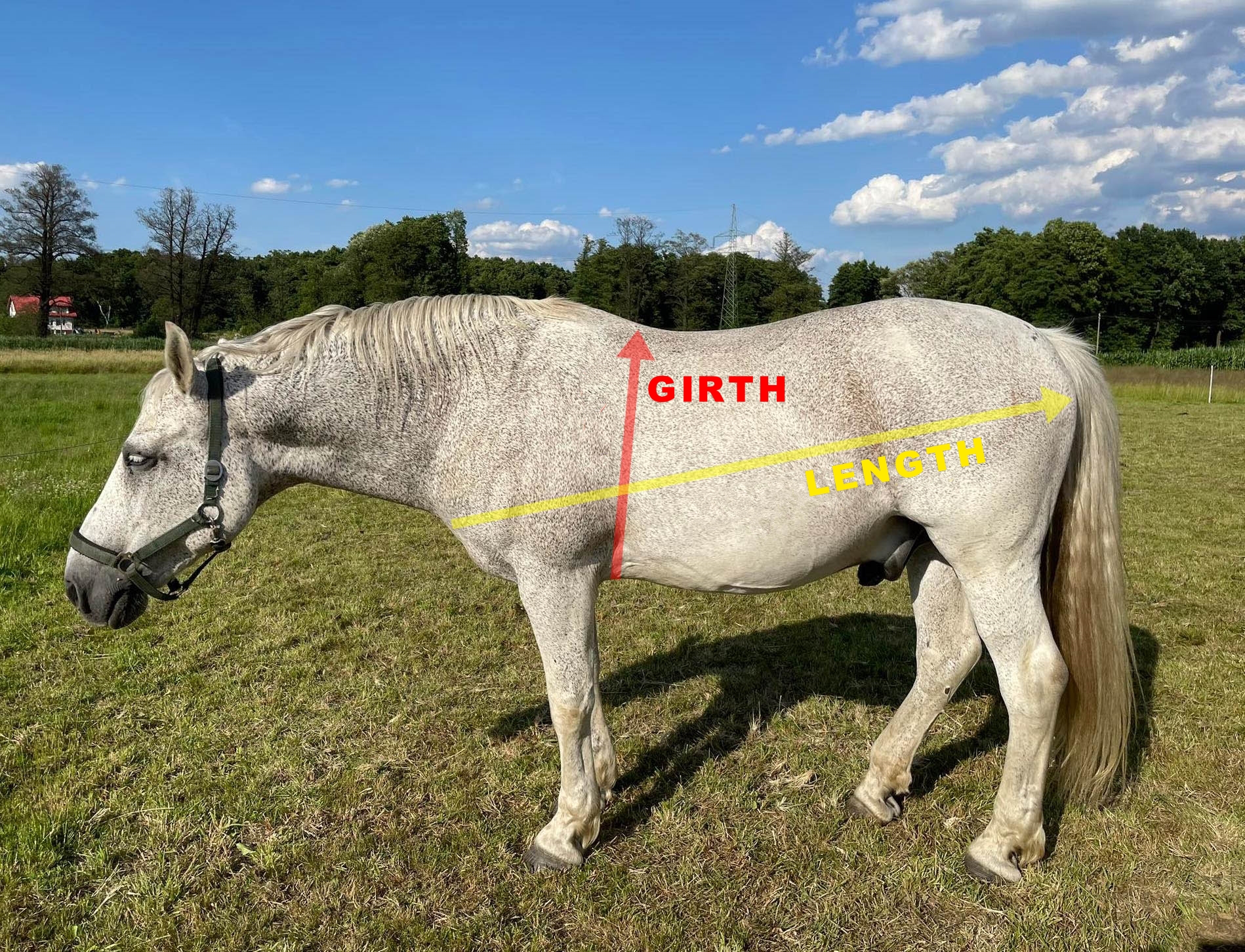
Horse weight and age
An average weight of a horse can also be estimated based on its age. It’s generally assumed that a newborn foal weighs around 10% of its mother's weight. Weanlings usually gain 1.98 - 2.43 lbs (0.9-1.1 kg) a day. Yearlings should weigh around 50% of an adult horse's weight. Two-year-old horses weigh around 90% of an adult horse's weight. Horses reach their full body weight at 4 years old.
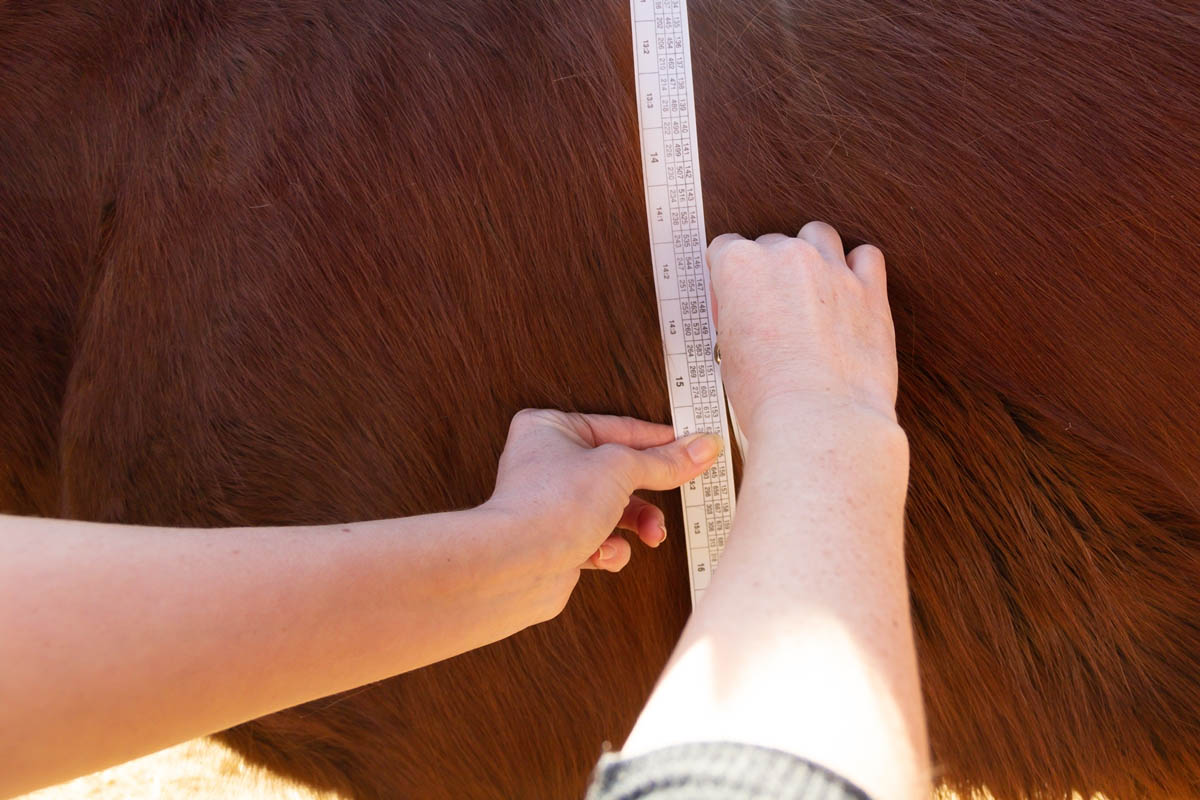
How to determine the weight of a horse?
If you want to determine the approximate weight of your horse, then you can use a special tape or calculation formula. However, you must remember that the results will always be indicative.
Horse weight tape
You can find a special equestrian tape designed to measure a horse’s approximate size, girth, and weight. According to the instructions, measure the girth of the animal's belly along the length between the front legs and the withers. As a result, you will get the measurements of the girth of the chest, the horse's weight in kilograms, as well as its height.
Sasimowski and Budzyński’s formula
The approximate weight of a horse can also be calculated by using a formula created by Sasimowski and Budzyński. First, measure the girth of the body, through the point of the shoulder joint and the buttock of the horse. Then measure the girth of the chest behind the horse's withers and elbow. Finally, substitute the obtained values into the formula: longitudinal circumference of the trunk (cm) x girth of the chest (cm) x breed factor.
The formula can be presented this way: C = O x P x W. O means chest girth, and P means the longitudinal circumference of the body measured from the outer areas of the shoulder joints and buttocks. Both of the results should be entered to the nearest 0.01. The last letter W indicates the relevant weight index of the horse that is calculated with a formula: W = C / O x P.
Breed index:
If a breed doesn’t belong to any of the groups above, then you should use the average breed ratio.
Caroll and Huntington's method
This formula is regarded as more precise. You should first measure the chest girth and then the horse’s length from the shoulder to the buttocks. The results should be substituted into this formula: [chest girth (cm)2 x length (cm)] / 11877.

BCS method
The body Condition Scoring method was created by Don Henneke over 40 years ago. In this method, the body condition is determined with the use of sight and touch. The scale ranges from 1 to 9, where 1 means extreme emaciation and 9 means extreme obesity. A healthy and normal horse scores from 4 to 6 points. It is important to remember that BCS is a method that focuses on an objective assessment of the horse's present condition. You should always consider the horse’s individual characteristics because many factors influence the condition. The BCS focused on 5 different body parts:
Neck and withers
- 1 – Lack of visible fat. The neck is limp, while the withers have visible bone structures.
- 2 – The neck crest is collapsed and noticeable. The withers are bony.
- 3 – The neck crest is collapsed and doesn’t have an even connection with the body. There is a thin layer of fat around the crest and withers.
- 4 – The neck has an even connection with the body; there is visible fat on it.
- 5 – A normally looking neck with an appropriate amount of fat. The neck crest is nicely blended with the body and rounded near the withers.
- 6 – There is palpable fat on the neck and both sides of the withers.
- 7 – There is visible fat on the neck crest and faintly highlighted withers.
- 8 – The neck is visibly enlarged and gives the impression that the fat is detached.
- 9 – The neck is very fat. The fat can gather only on one side of the neck. The withers have visible fat deposits.
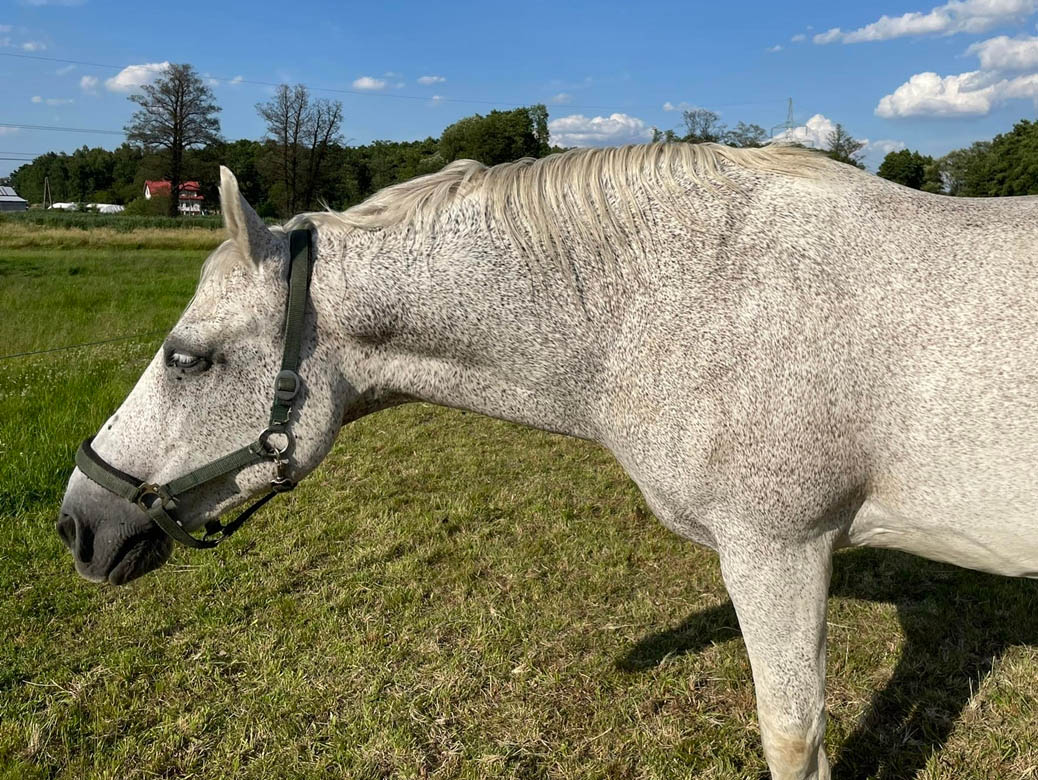
Shoulder
- 1 - The shoulder bones are very easily noticeable.
- 2 – The shoulder is visible; there I no palpable fat.
- 3 – The shoulder is slightly visible.
- 4 – The shoulder is barely visible.
- 5 – The shoulder is covered with barely palpable fat.
- 6 – There are slightly visible and palpable fat deposits on the shoulder.
- 7 – The fat deposits on the shoulder and surrounding area are easily palpable.
- 8 – The area near the shoulder is visibly filled with fat.
- 9 – There are very noticeable fat deposits.
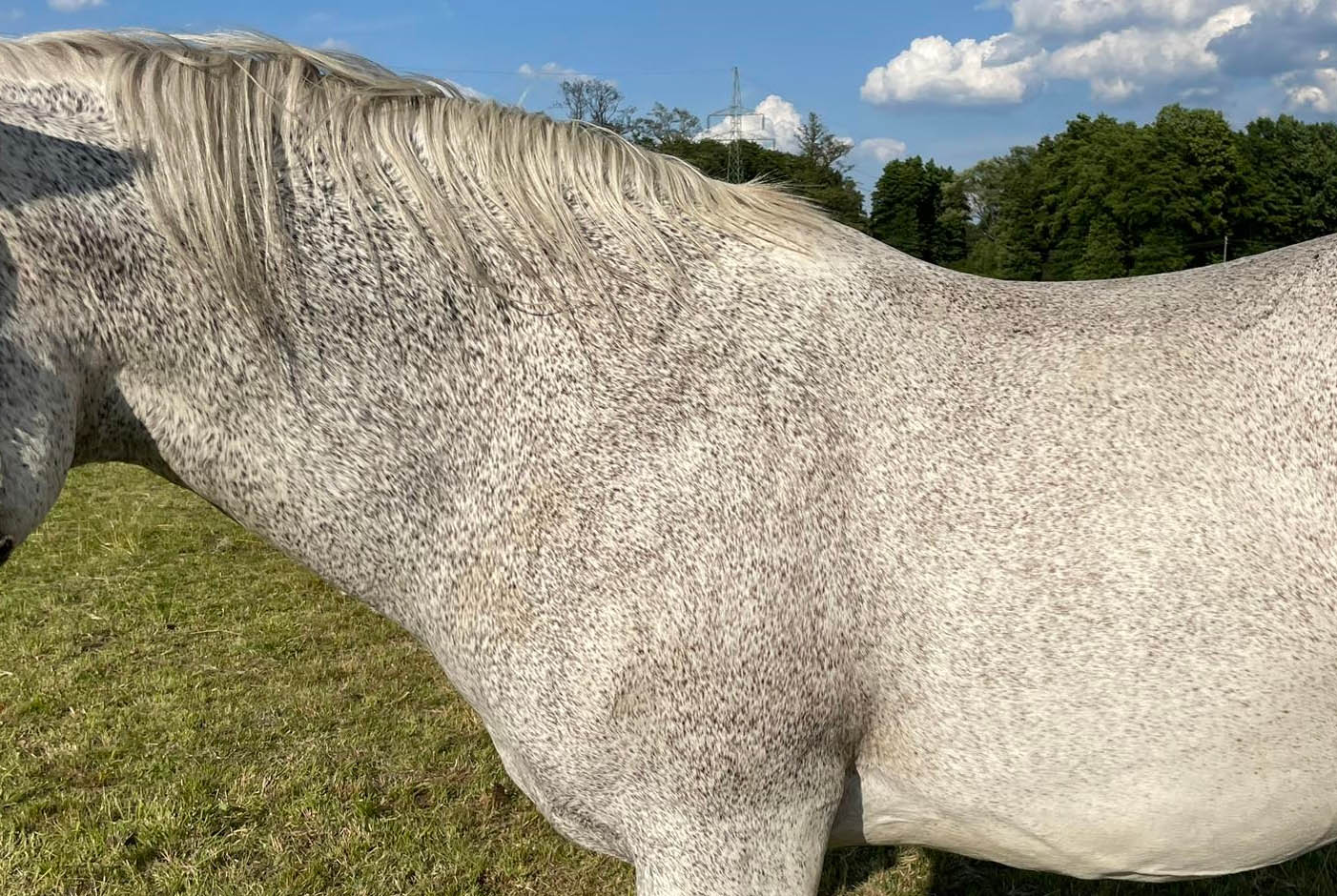
Ribs
- 1 – The ribs are sticking out and are very noticeable. There is no fat.
- 2 – The ribs are sticking out but have a very thin layer of fat.
- 3 – Visible ribs with a thin layer of fat.
- 4 – The ribs are barely visible.
- 5 – The ribs are not visible but palpable.
- 6 – The ribs are surrounded by fat tissue, palpable but extra force is needed.
- 7 – The ribs are hard to feel under the fat tissue.
- 8 – The ribs are practically not palpable.
- 9 – The ribs are visibly filled with fat.
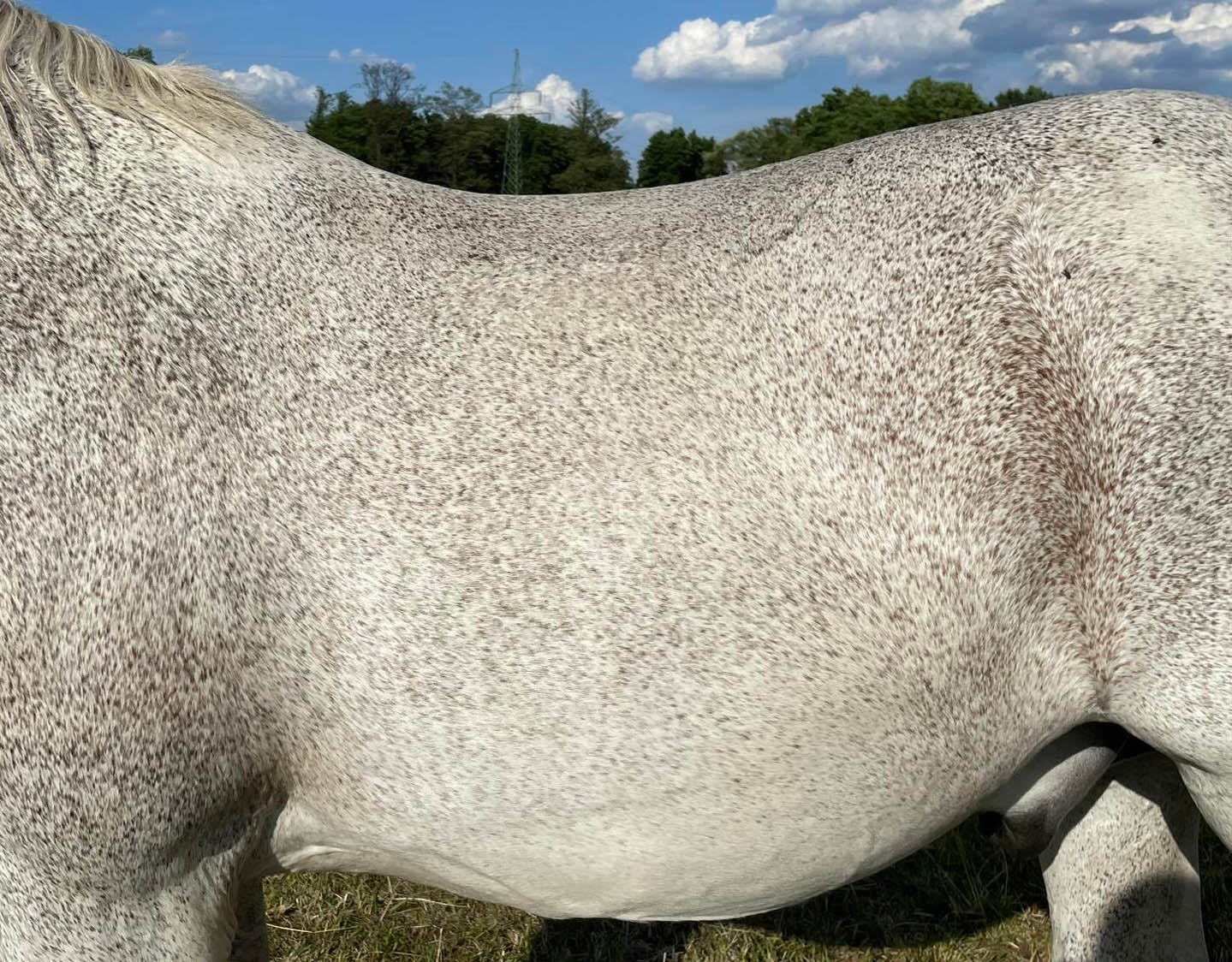
Back
- 1 – The spine is very prominent, and the structure of the vertebrae is very noticeable.
- 2 – The spine is visible and there is a very thin layer of fat over the vertebrae.
- 3 – There is a thin layer of fat, and the spine structure is barely noticeable.
- 4 – The back is slightly built.
- 5 – The back is raised adequately with a proper amount of fat. The spine ridges are not visible but palpable.
- 6 – The spine ridges are slightly palpable; the back is soft to the touch.
- 7 – The spine ridges are barely palpable and at the back, there is a fat layer that is easily palpable.
- 8 – There is a visible fat crease that runs along the spine, which is not palpable.
- 9 – The fat crease is very prominent, with big fat deposits on both sides of the spine. The spine is not palpable.
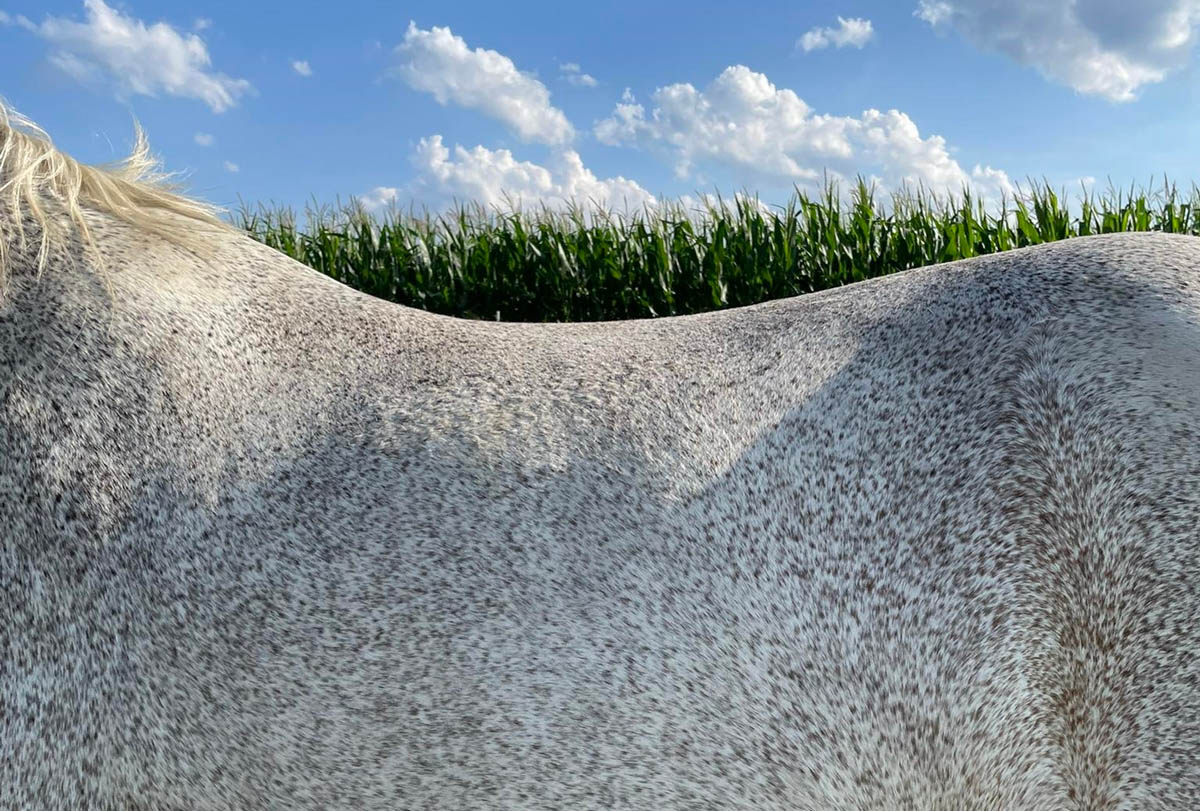
Tailhead area
When scoring this area, you should focus on the tailhead, however, the whole croup should also be taken into consideration.
- 1 – No palpable fat. There is muscle atrophy and the tailhead, point of hip and buttock are very prominent.
- 2 – The tailhead, the hip and buttock points are sticking out, and small amounts of fat can be seen.
- 3 – There is some palpable fat around the tailhead. The hip points are not visible.
- 4 – There is palpable fat around the tailhead. The buttock points are not visible.
- 5 – The tailhead is covered with soft fat tissue, and the tail dock is palpable.
- 6 – There is soft, visible, and evenly distributed fat around the tailhead.
- 7 – The fat around the tailhead is noticeable.
- 8 – The tail dock is enlarged and surrounded by a significant amount of fat. The tail might appear as “halved”.
- 9 – The tailhead is filled with very large amounts of fat. The tail is visibly “halved”.

Underweight or overweight horse
If you tried any of these methods and discovered your horse has a weight that is outside the healthy weight brackets, then it might be a signal to start acting. Firstly, you should reevaluate your horse’s diet and its exercising plan. How much food a horse should eat depends on many factors, among others: the amount and intensity of exercise, age, health, and sex. If a horse is overweight, then it’s crucial for it to lose weight. Overweight horses are prone to many health problems such as laminitis, arthritis, and heart problems. Too much weight puts excess stress on the whole body. If a horse is underweight, then it must gain weight. A small percentage of body fat results in low energy, health problems (for example Cushing’s disease), and an ineffective immune system. Most of the time, unhealthy weight requires changes to the horse’s diet. However, those changes should be done with caution. If you don’t have enough experience, it might be a good idea to ask an equine nutritionist for advice. Don’t forget that grazing also counts towards consumed calories, therefore sometimes overweight horses might benefit from using a grazing muzzle. Any concerning or drastic changes to the horse’s weight should be consulted with a veterinarian since they might be linked to some health issues.
Horse’s weight and the rider’s weight
It’s estimated that the rider’s weight should be approximately 10 to 15% of the horse's weight. Therefore, if a horse weighs 1102 lbs (500 kg), then the perfect rider for that animal would weigh around 110 to 154 lbs (50 to 70 kg). Riders with a larger body weight should choose horses that can carry more weight. A horse that is ridden by a too heavy rider can develop a plethora of health problems. Too much pressure can lead to spine, joint, and muscle disorders as well as lower quality of movement, and reluctance to be ridden. It should be noted that the percentage is an estimated value – weight is not the only factor that determines the weight a horse can carry.
The lowest and highest horse weight
The Guinness Record for the smallest male horse is taken by a pony named Bombel. Currently, Bombel lives in a stud in Łódź. He weighs only 132 lbs (60 kg) and is only 56,7 cm tall. The record has been officially recorded on the 24th of April 2018.
The heaviest horse in history was Sampson – a Shire horse. He was born in 1846 in Toddington, England. He weighed 3307 lbs (1500 kg) and was around 230 cm tall. When he was 4, his name was changed to Mammoth.
Summary
The horse’s weight depends on many factors. It’s practically impossible to precisely determine the horse's weight, however, there are some methods and calculations that allow you to discover an approximate weight. It’s estimated that foals after being born weigh around 10% of their mother’s weight. Whereas most horses that are 160-170 cm tall weigh on average 1102 to 1323 lbs (500 to 600 kg). Draft horse weigh over 1763 lbs (800 kg) – the heaviest horse was the Shire named Sampson. Regular monitoring of your horse's weight is also very important, as it allows you to react quickly in case of any deviations from the norm that may indicate health problems.
